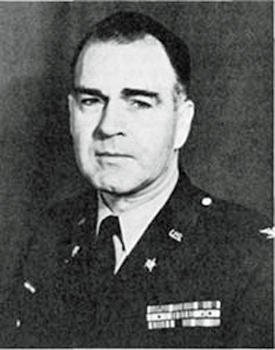

David Lincoln Edwards
Commanding Officer 22nd Infantry
4th Infantry Division
1953-1954?
David L. Edwards was born in Youngstown, Ohio on April 10, 1912.
He entered the United States
Military Academy on July 1, 1932. He graduated 253 out of a class
of 276
with a Bachelor of Science degree on June 12, 1936. While at the
Academy his best subjects were Military
Hygiene and Economics & Government and his worst subjects
were Law and Ordance & Gunnery.
|
Above and left: The entry for
David L. Edwards in the |
Upon graduation Edwards was commissioned a 2nd Lieutenant of Infantry.
Edwards served on temporary duty
with the 16th Infantry at Fort Jay, New York and Camp Dix, New
Jersey
from September 12, 1936 to January 5, 1937. From January 5-29,
1937 he was on leave and en route to
station. From January 29 - February 25, 1937 he was en route to
the Philippines. On February 25 he reported
to the 31st Infantry at Manila where he commanded a Platoon and
was also Gas and Mess Officer. He remained
in these duties until April 10, 1939 when he departed for the
United States. Upon arrival he then took leave.
On June 12, 1939 Edwards was promoted to 1st Lieutenant of Infantry.
From August 29 - September 11,
1939 he was at Fort Benning, Georgia with the 29th Infantry. On
September 11
he reported to the Infantry School at Fort Benning as a student
officer, graduating from the Officers Regular Course
on February 5, 1940. From February 5 - May 25, 1940 he was on
temporary duty with the 26th Infantry and the 97th
Observation Squadron at Fort Benning, Georgia, Natchitoches,
Louisiana, Meridian, Mississippi and McNutt, Louisiana.
From May 25 - June 14, 1940 he
was on leave and en route to station. On June 14 he reported to
Plattsburg Barracks,
New York where he became a Company Commander in the 26th
Infantry.
On September 9, 1940 Edwards was offered a temporary promotion to Captain (AUS) which he accepted on October 9.
He was promoted to the temporary rank of Major (AUS) on June 6, 1942.
He graduated from the Command and General Staff School, 7th General Staff Class in 1942.
In 1943 he was sent to the
Pacific Theater of Operations. He was promoted to the temporary
rank of Lieutenant Colonel (AUS)
on June 22, 1943. In 1943 he assumed command of the 77th
Amphibious Tractor Battalion and led the Battalion in the
invasions
of Saipan and Tinian in 1944 for which he was awarded the Legion
of Merit and Army Commendation Medal.
He assumed command of the 3rd
Battalion 391st Infantry 98th Infantry Division in late 1944 and
was awarded the Bronze Star
Medal during that command. He was with his Battalion on
occupation duty on the island of Honshu, Japan beginning in
September 1945.
Edwards was promoted to Captain of Infantry in the Regular Army on June 12, 1946.
He remained on duty in Japan into 1946.
From July 1, 1946 to August 20,
1947 he was Fort Monroe, Virginia on duty in the G-3 Operations
Section of the
Army Field Forces Headquarters. From August 21, 1947 to July 1,
1948 he was a student officer at the Command
and General Staff College at Fort Leavenworth, Kansas. Upon
graduation from the course he remained at the College
as a member of the Staff and Faculty.
Edwards was promoted to Major of Infantry in the Regular Army on July 15, 1948.
On September 10, 1952 he was
promoted to the temporary rank of Colonel (AUS). That same year
he graduated
from the Armed Forces Staff College.
Edwards was promoted to Lieutenant Colonel in the Regular Army on July 7, 1953.
The exact dates of his command
of the 22nd Infantry in Germany are unknown at this time. Best
estimate is that he
commanded the Regiment during the 1953-1954 time frame.
Retired Lieutenant General John
H. Cushman served under Edwards as the S-3 Operations Officer for
the 22nd Infantry
in Germany. The following passages from an interview Cushman gave
for the Center of Military History give Cushman's personal
recollections of Edwards as Regimental Commander of the 22nd
Infantry.
GEN CUSHMAN: Soon after we
arrived in Giessen we received a new regimental commander,
Colonel David Lincoln Edwards,
USMA 1936. Hartness chose Edwards to be the regimental commander.
He had known Edwards at Fort Leavenworth where
Edwards had been on the faculty of the staff college when
Hartness was commandant. In World War II Edwards had commanded
an AMTRAK battalion in the Pacific. Now he was commanding an
infantry regiment and he was a character. He had ideas of his own
and he was different.
He was a disciplinarian and hard
to work for. Within a couple of weeks he had relieved his S1, S2
and S4 but he kept me as the S3.
I satisfied him but I had to stand up to him because he had
peculiar ways. He didn’t tinker around with me. Although he
growled
at me from time to time he didn’t give me orders to shape
up. Among his many ideas he started a punchbowl ceremony for the
22d Infantry and he made an effort to a football team and he put
the players in a separate barracks with special treatment, not
a good idea. He took a platoon leader who had played football at
West Point and made him coach. It broke his heart.
INTERVIEWER: How was he as a trainer?
GEN CUSHMAN: He was all right.
He favored participatory training led by an instructor in small
groups that he called skull sessions.
He knew his tactics and staff procedures from having been on the
faculty at Leavenworth.
INTERVIEWER: How was your relationship with Colonel Edwards?
GEN CUSHMAN: Colonel Edwards was a character, but he took a
liking to me. He had strange ways. His daughter wrote a book
called “Military Brats - Legacies of Childhood Inside the
Fortress” that describes him and she’s not
complimentary to her Dad. His
wife was a lovely woman. I remember once the Edwardses had Nancy
and me to dinner in his quarters. I asked for a second helping
or something and Nancy said, “Jack, you’re eating too
much,” or something like that, and Dave Edwards says to
Nancy,
“You don’t feed toothpicks to a blast furnace.”
I will insert into this oral
history one experience working for Colonel Edwards. In April 1953
I was regimental field officer of the day.
We had recently moved into in our newly built kaserne at
Kirch-Goens. Many years later I found in my officer’s
records folder a copy
of a four-page report that I had written on that occasion. ...It
must have been included in the OER submitted by Colonel Edwards
as something he liked.
I was working my butt off for Colonel Edwards and he liked that.
We were going to the Grafenwoehr training area for six weeks,
and he wanted to make good use of that period. I went to
Grafenwoehr and looked at the ranges. I went to a range
conference and
got the ranges I thought we needed for the programs we had in
mind. Then I went back and worked very hard to write schedules
for those ranges. I drew up the training program, and then I drew
up problems building scenarios for the ranges and a rotation
schedule for the battalions. I had a six inch stack of training
and lesson plans that I showed to Colonel Edwards. I said,
“This is what you’re going to do in Grafenwoehr.”
He thought that was great.
So we went to Grafenwoehr and he
was very pleased with me. I was in his confidence and I liked
that. I’d been the Regimental S3
for eight or nine months and we were conducting a battalion field
problem. The 2d Battalion was given a mission. It had to cross
the line of departure at, say, 0600. At 0600 Colonel Edwards
called the battalion commander on the command net and asked
where his battalion was. The battalion commander replied that he
was at the line of departure. The regimental commander was at
the line of departure and he could see that the 2d Battalion was
many minutes away. So Colonel Edwards relieved him.
When I found that out I went
away for half an hour and came back. I said to Colonel Edwards,
“Sir, I think I can command
that battalion.” He said, “I’ll go down to
division right away and arrange it.” He came back later and
said, “You’ve got it.”
So now I’m battalion commander and under the direct command
supervision of Edwards. He wanted to tell me how to run
my battalion. I had to stand up to him. I had my own ideas about
commanding a battalion.
He was a nut on statistics. He
tracked AWOLs very closely. If a man was not present at morning
formation you had all day
to get him back to duty and if he’s not there at midnight
he’s AWOL on the morning report. Colonel Edwards’
practice
was if a man was AWOL on the morning report his battalion and
company commanders had to report to the regimental commander
that morning and explain why the man was absent. That was an
ordeal, that’s not a good leadership technique.
Company commanders were sending platoon sergeants down to the
gasthauses to round up AWOL soldiers.
Every month Colonel Edwards would have a meeting with his
officers and NCOs down to platoon sergeant and he would
go through the statistics for each battalion. He would give the
number of AWOLs, the number of sick calls, and then he
would have a number of DRs, [Delinquency Reports] written up by
the military police in town. These documented minor
offenses like being out of uniform, or driving too fast, or
misbehaving. It turned out on one particular month the 2d
Battalion
hadn’t had a single DR. That was pretty unusual. When
Edwards found out he said to me, “What deal have you made
with those MPs?” That was the kind of guy he was. But he
treated me all right. We were his best battalion by many
measures.
From the Oral History Project by historian Robert Mages of the US Army Military History Institute at Carlisle Barracks, PA. 2009
From West-Point.Org
Edwards graduated from the National War College in 1955 with the distinction of Equivalent of Infantry Advanced Graduate.
He was promoted to Colonel in the Regular Army on June 12, 1961.
He retired from the Army on January 3, 1966.
David L. Edwards died on April 10, 1985
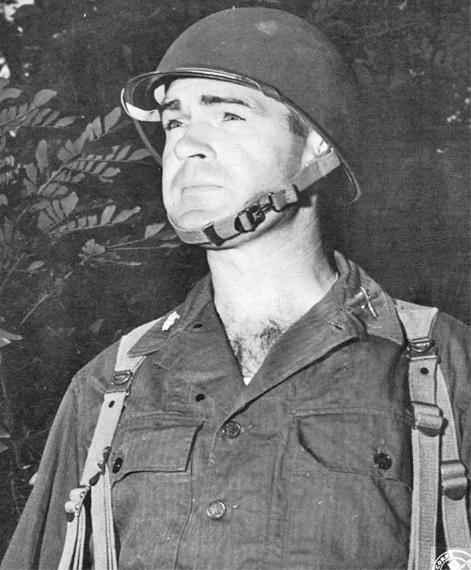
Lieutenant Colonel David L. Edwards as
Commanding Officer
3rd Battalion 391st Infantry 98th Infantry Division
Photo from The History of the 391st Infantry Regiment 1946
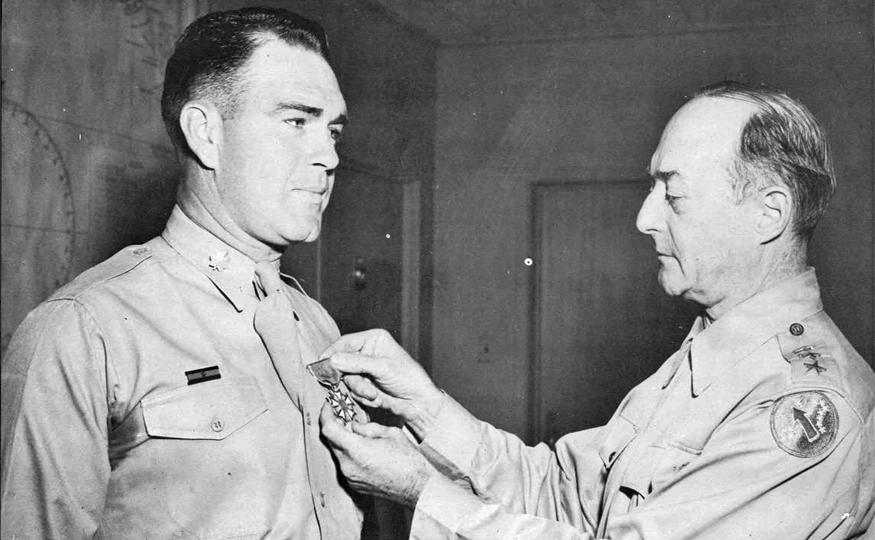

Before becoming Battalion Commander of
the 391st Infantry David L. Edwards had commanded the
77th Amphibious Tractor Battalion (Am-Tracs) in the invasion of
Saipan and Tinian. In the above photo
he is being awarded the Legion of Merit for his actions in those
battles by Lieutenant General Robert C. Richardson,
Commanding Officer U.S. Army Forces Middle Pacific. The award was
presented in April 1945.
Photo from The History of the 391st Infantry Regiment 1946
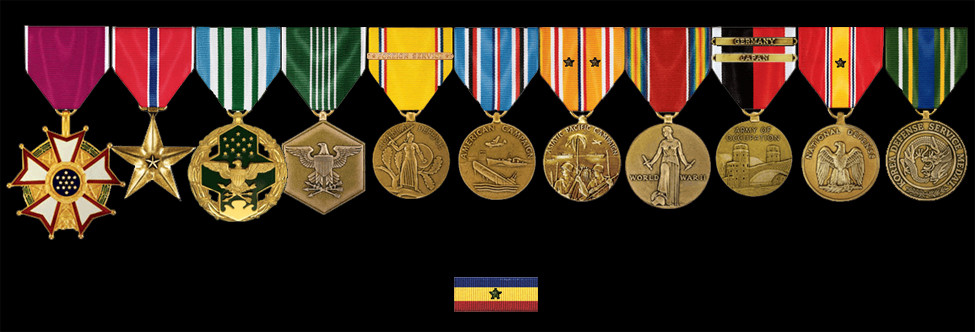
COL David L. Edwards' decorations
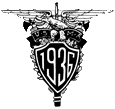
David Lincoln Edwards was born
in Youngstown, Ohio on 10 April 1912, the son of a Welsh
immigrant who instilled
a fierce sense of patriotism in his children. His father, David
John Edwards, served as a US Marine in the Spanish-American
War and as a US Army artillery officer in France during World War
I, retiring in 1935. He later served on the draft board
in Youngstown and helped found the local chapter of the American
Legion.
David attended grammar school and high school in Youngstown and
was appointed to the United States Military Academy
from the 19th Congressional District of Ohio.
While at the Academy he was active in the Dialectic Society,
Choir, and the Color Line. He played on the lacrosse team
and coached the plebe lacrosse and football teams. One of his
favorite memories of cadet years was the "Hundredth
Night”
show in 1936, which he coauthored and in which he also performed.
Shortly after graduation he was sent to the Philippines with the
31st Infantry. In 1939-40 he attended the Infantry School in Fort
Benning,
Georgia and then went to Plattsburg Barracks, New York where he
was a company commander of the 26th Infantry.
During World War II he commanded the 77th Amphibious Tractor
Battalion and the 3rd Battalion, 391st Infantry in the Pacific
Theater,
seeing action at Saipan and Tinian. He earned the Bronze Star
Medal, Legion of Merit and Army Commendation Ribbon.
Following the war he attended the National War College, the Armed
Forces Staff College, and was on the staff and faculty of the
Command and General Staff College. He commanded the 22nd Infantry
Regiment at Butzbach, West Germany from 1952-54.
From 1956-58 he was deputy commander and chief of staff of the
Military District of Washington, then served a year in Korea
as comptroller of the Eighth Army. Subsequent assignments were
with the 82nd Airborne Division at Fort Bragg, North Carolina
and as comptroller with the US European Command in Paris, France.
He retired from the Continental Army Command at
Fort Monroe, Virginia where he was deputy chief of staff for
Individual Training in 1966 with the rank of colonel.
In 1939 he married Dorothy Nell Kimbrell of Athens, Georgia,
whose brother, Gordon T. Kimbrell, graduated from USMA
in the Class of 1937. They were divorced in 1978, and Dorothy
Edwards now resides in Athens. Colonel Edwards remarried
in 1980. He is survived by his widow, Rita; his son, David Jr.,
of Flagstaff, Arizona; his daughter, Mary Edwards Wertsch of San
Diego,
California; a stepson, Paul Sternberg of Los Angeles, California
and a stepdaughter, Lorraine Sternberg of Hampton, Virginia.
Dave Edwards will be remembered by all who knew him for his quick
humor, his superb storytelling ability, and as a dedicated
servant of his country. At his funeral in Hampton, Virginia his
son and daughter recalled their father’s pride in his Welsh
heritage
and in the tradition of military service so common among Welsh
people and in his own family. They read from a poem titled
"Retrospection,” written by their grandfather,
Lieutenant Colonel (Ret) David John Edwards in 1936, just a month
before
his son’s graduation from West Point. The poem read in part:
"I will not look behind: for there the night
Draws on, and forward all is light.
I smiling take the path that calls to me,
and leads me to the goal—Eternity.”
From the West Point Association of Graduates website
There is a memorial marker for
David L. Edwards in the Hampton National Cemetery,
Hampton, Hampton City, Virginia, Plot: SECTION MA SITE 39
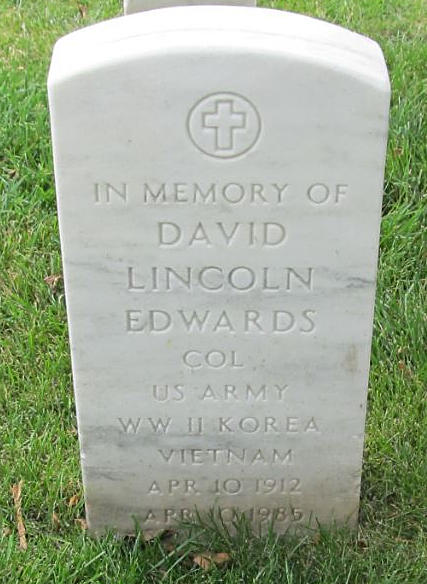
Memorial marker for David L. Edwards
Photo by Ron Stewart from the Find A Grave website
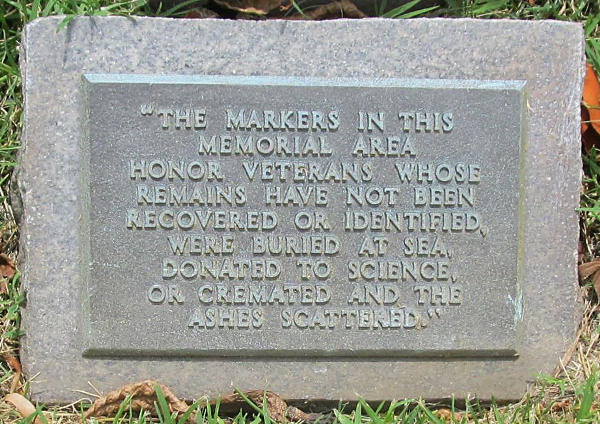
Marker for the section where the
memorial marker for David L. Edwards is located.
Edwards' ashes were scattered at sea.
Photo by Ron Stewart from the Find A Grave website
Top photo from the West Point Association of Graduates website
Home | Photos | Battles & History | Current |
Rosters & Reports | Medal of Honor | Killed
in Action |
Personnel Locator | Commanders | Station
List | Campaigns |
Honors | Insignia & Memorabilia | 4-42
Artillery | Taps |
What's New | Editorial | Links |